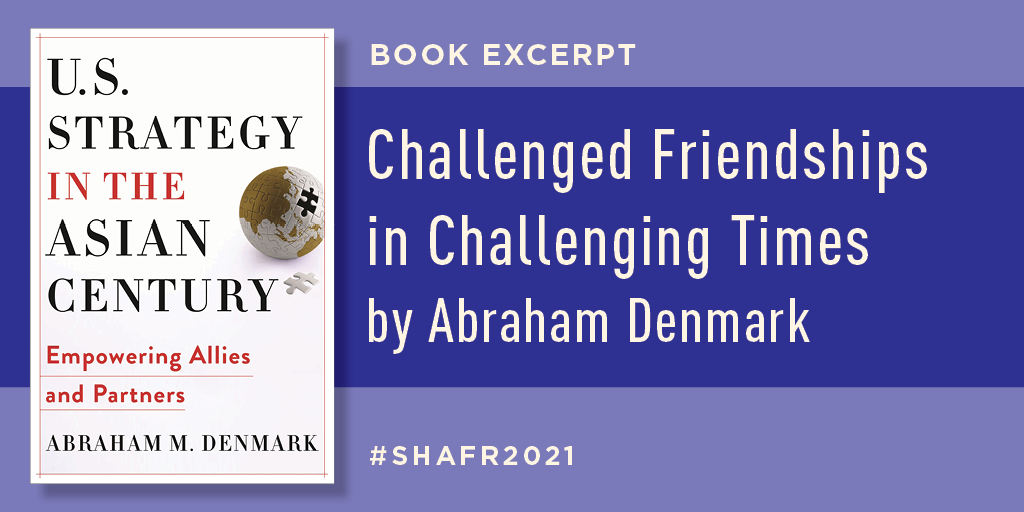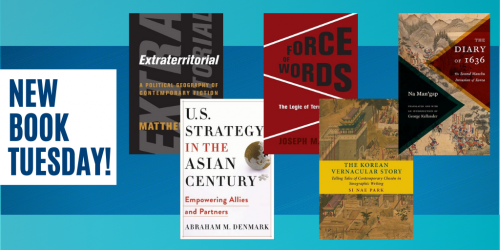Challenged Friendships in Challenging Times
From the Introduction to U.S. Strategy in the Asian Century
By Abraham Denmark

As the twenty-first century seems to be dominated by great power competition between China and the United States, everyone wonders whether war will come and how to avoid it. In U.S. Strategy in the Asian Century: Empowering Allies and Partners, Abraham M. Denmark argues that the United States will only find the route to security by traveling alongside our Asian allies. What follows is a short excerpt from the introduction of the book.
• • • • • •
“We cannot always assure the future of our friends; we have a better chance of assuring our future if we remember who our friends are.”
—Henry Kissinger
Allies and partners have played an important role in American foreign and national security policy since before its founding. France was a key supporter of the American revolution—providing George Washington and the Continental Army with supplies, weapons, financing, and the much-needed diversion of English focus outside of North America in their global competition for power. Despite President Washington’s admonitions to future generations that “the great rule of conduct for us, in regard to foreign nations, is in extending our commercial relations, to have with them as little political connection as possible,” American leaders and strategists have long understood that its power was augmented with strong foreign relationships.
Historically, allies and partners have functioned both as a complement to American power and a conduit for it. Though not formal allies at the time, the United States came to the aid of France and Great Britain for World War I and World War II, laying the foundation for a collective defense arrangement that has lasted for decades. It was the post-war era when the United States established the structure of its East Asian alliances and partnerships, which during the Cold War served to deter large-scale Soviet aggression and contain the spread of communism while also enabling the United States to exert its influence globally.
As the geopolitical environment has evolved and American interests have changed, Washington’s approach to alliances and partnerships have evolved as well. Following the collapse of the Soviet Union and the Eastern bloc, NATO has acted beyond its traditional writ to stop genocide in the former Yugoslavia and later augmented the U.S. liberation of Afghanistan after the attacks of September 11, 2001. In Southeast Asia, the spread of terrorist organizations in the early twenty-first century spurred the United States to revitalize its alliances and partnerships in the region to fight their spread and counter their attacks.
…American leaders and strategists have long understood that its power was augmented with strong foreign relationships.
Today, the Indo-Pacific looms large as a vital region for American economic, political, and security interests. The region’s importance to the United States was the motivating factor behind the Obama administration’s rebalance to the Indo-Pacific. As described by Dr. Kurt M. Campbell, a principal architect of the rebalance,
Asia is now beginning to lead the globe in almost every metric, often in ways that illustrate the region’s potential and its challenges, and sometimes in ways that appear both surprising and contradictory. The region is home to the world’s largest emitters of greenhouse gases, but also its biggest investors in green technology. It houses the world’s largest urban population, but most of its countries have some of the world’s lowest urbanization rates. It is a region that uses more power than any other, but one-fifth of its population still lacks access to electricity.
Yet just as this region continues to grow in significance for the United States, the fundamental dynamics of its geopolitics are in the midst of a fundamental change. China is steadily growing more powerful, and is increasingly assertive in the pursuit of its objectives. Concurrently, American power in the region is seen across the region as insufficient and unreliable.
This book argues that these changes to the regional balance of power threaten the liberal regional order, which has been fundamental to regional stability and prosperity for decades. It also argues that the regional balance of power is no longer only about military capacity, but is rather involves multiple measures of national power—including trade and investment flows, economic throw-weight, technology standards, soft power, and military potential. This book assesses that U.S. allies and partners are adopting hedging strategies to account for these changes, and proposes a strategy for the United States to empower its regional allies and partners to help strengthen those critical relationships and defend the key principles that are the foundation of the liberal regional order.
As their power rises, America’s allies and partners in Asia have an opportunity to contribute more to the health and success of a rules-based liberal order that has been critical to the region’s stability and prosperity for generations.
This calls upon the United States to adjust the original conceit of its approach to alliances and partnerships, which were as much about restraining allies as about confronting threats. Indeed, as persuasively argued by Georgetown University professor Victor Cha, the United States established its alliances with Korea (in 1953) and the Republic of China (1954) in order to both contain communism and to stop the Syngman Rhee and Chiang Kai-shek governments from respectively provoking conflicts with North Korea and mainland China. For the U.S. alliance with Japan (1951), the United States was less concerned about Tokyo entrapping it in an unwanted conflict, but more that Japan’s postwar recovery would occur without U.S. involvement. While the rationale for these alliances have evolved significantly over time, the military-centric, hub-and-spoke system that grew out of the U.S. approach to Asian alliances in the early 1950s remains the foundation of its strategy today.
Yet a military-centric approach is insufficient in a region where the balance of power in the Indo-Pacific is increasingly measured via a continually evolving assessment of hierarchies of relative levels of existing and potential national power. Further states will perceive a series of power hierarchies among various measures of national power, be it overall economic strength, the resilience of domestic politics and economics, per-capita income and innovation, defense budgets, qualitative assessments of military capabilities, geography, and soft power. These multiple, interrelated hierarchies—referred to as a heterarchy—will inform great power competition in the Indo-Pacific and likewise drive the development of strategies by the region’s middle powers to hedge against tremendous strategic uncertainty. This means that the United States cannot focus solely on military power, but must involve all aspects of national power in its strategy toward the Indo-Pacific. From trade and investment to development and security assistance, this monograph argues for the United States to tailor its regional strategy to the demands of the emerging era of complex regional competition.
This book primarily focuses on the need for the United States to empower its Asian allies and partners, many of which are focusing more on the role they will play in the emerging Indo-Pacific heterarchy. As their power rises, America’s allies and partners in Asia have an opportunity to contribute more to the health and success of a rules-based liberal order that has been critical to the region’s stability and prosperity for generations.
Abraham M. Denmark is director of the Asia Program and a senior fellow at the Kissinger Institute on China and the United States at the Woodrow Wilson International Center for Scholars, and an adjunct associate professor at Georgetown University.
You can use the code SHAFR at checkout from our website for a 20 percent discount on this book or any of our conference titles through July 31, 2021.








